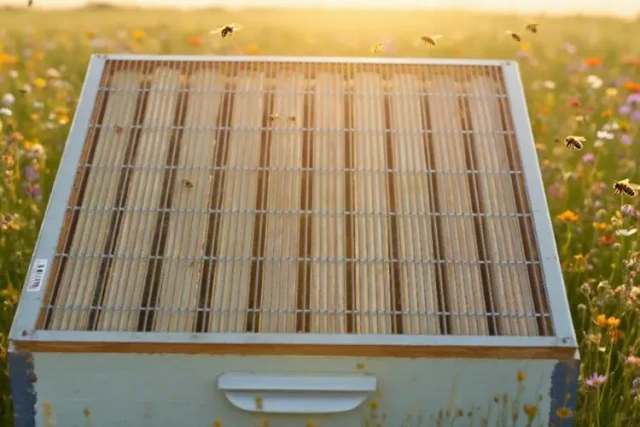Queen excluders are among the most debated tools in beekeeping—when used correctly, they can streamline hive organization and boost honey purity, but improper placement risks swarming, blocked honey flows, and stressed colonies. This guide synthesizes biological insights and field-tested strategies to help beekeepers make informed decisions.
Understanding the Role of Queen Excluders
The Biology of Brood Chambers vs. Honey Supers
Queen excluders act as selective barriers, allowing worker bees to pass while restricting the queen and drones. Their primary purpose is to separate the brood chamber (where eggs are laid) from honey supers (where nectar is stored). Research shows this segregation yields cleaner honey by preventing brood residue contamination and simplifies hive inspections.
However, bees don’t always comply with human-imposed boundaries. Colonies with locally bred queens often naturally limit brood nest size, reducing the need for excluders. In contrast, wild-caught bees may overproduce brood, making excluders beneficial for hive efficiency.
Why Placement Affects Colony Behavior
Positioning determines whether the excluder aids or disrupts colony workflows:
- Too low: Queens may squeeze through gaps, defeating the purpose.
- Too high: Workers may resist crossing it, leaving honey supers underutilized.
- Just right: Directly above the brood chamber, with a snug fit to prevent bypass routes.
Pro Tip: Some beekeepers add an upper entrance above the excluder to reduce congestion, encouraging bees to access supers without traversing the barrier repeatedly.
Step-by-Step Installation Best Practices
Positioning in Traditional Langstroth Hives
- Prep the hive: Remove all honey supers temporarily.
- Align the excluder: Place it flat atop the uppermost brood box, ensuring no gaps at the edges where queens could slip through.
- Reassemble: Return honey supers above the excluder.
- Monitor traffic: Check for worker bee resistance or blockages within 48 hours.
Adapting for Multi-Brood Box or Warre Hives
- Multi-brood systems: Install the excluder above the primary brood box (usually the lower one), as secondary boxes often serve as transitional storage.
- Warre hives: These vertical hives rarely need excluders due to their natural comb structure, but if used, place them below the first honey box after the brood chamber fills 80% of its space.
Common Mistakes and Their Consequences
Swarming Risks from Improper Exclusion
A misplaced excluder can trigger swarming by:
- Trapping the queen during a swarm impulse, forcing workers to leave without her.
- Restricting brood nest expansion, prompting colonies to outgrow their space prematurely.
Honey Flow Blockages and Mitigation
Signs of blockage include bees:
- Clustering below the excluder instead of storing nectar above it.
- Propolizing gaps in the excluder, further narrowing passageways.
Solution: Temporarily remove the excluder during heavy nectar flows or opt for models with wider spacing (e.g., plastic excluders with 4.2mm gaps vs. metal’s 4.0mm).
Alternatives and Advanced Considerations
When to Skip the Queen Excluder
Consider omitting it if:
- Your colony shows reluctance to cross it (e.g., honey supers remain empty).
- You prioritize natural comb building, as excluders can distort worker movement patterns.
Comb Compatibility: Plastic vs. Metal Excluders
| Type | Pros | Cons |
|---|---|---|
| Plastic | Lightweight; less propolis buildup | Warps in heat; shorter lifespan |
| Metal | Durable; precise spacing | Heavy; can corrode over time |
Field data suggests plastic suits warmer climates, while metal excels in humid regions.
Ready to Elevate Your Apiary’s Efficiency?
HONESTBEE’s beekeeping equipment helps commercial apiaries and distributors optimize hive productivity with biologically informed tools. Explore our wholesale solutions today—because smarter beekeeping starts with the right foundation.
Products You Might Be Looking For:
View queen excluders for beekeeping
Related Products
- Professional Plastic Queen Excluder for Modern Beekeeping
- Wooden Queen Bee Excluder for Beekeeping
- Premium Wood Framed Metal Wire Queen Bee Excluder
- Metal Queen Bee Excluder for Beekeeping
- High Performance Plastic Queen Excluder for Beekeeping and Apiary Management
Related Articles
- How to Transition Hive Frames Safely Without Disrupting Colony Health
- How Queen Excluders Optimize Hive Productivity and Honey Quality
- How Beekeepers Can Choose the Right Comb Reinforcement for Hive Health and Durability
- How Comb Architecture Dictates Hive Productivity: A Beekeeper's Guide
- How to Optimize Queen Excluders for Healthier Bees and Better Honey Harvests




















